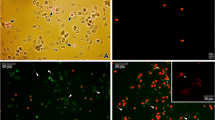Abstract
The effects of tonicity, digestive enzymes and bile salts, and various nutrients added to Locke’s solution were studied on the chemically excysted metacercariae of Echinostoma caproni. Metacercariae were maintained at 37.5°C in multiwell chambers, ten per 0.5 ml of test solution; each experiment was replicated five times. Most metacercariae maintained in deionized water or Locke’s 2× solution were dead within 2 h. About 85% and 55% of the metacercariae were alive at 8 h in Locke’s 1× and Locke’s 0.5×, respectively. Metacercariae of this species are osmoconformers, as is the case for adult digeneans. All metacercariae were dead in an acid saline or acid pepsin medium by 2 h. About 50% of the metacercariae were alive in an alkaline trypsin-bile salts medium at 4 h. These results suggest that the acidic pepsin environment in the stomach of a definitive host would be detrimental to the survival of excysted metacercariae, but prolonged survival in alkaline trypsin-bile salts would facilitate establishment of this larval stage in the mucosa of the host small intestine. Studies on excysted metacercariae in Locke’s 1× supplemented with various nutrients showed that optimal survival occurred in Locke’s plus 0.1% glucose and in Locke’s 1× plus 1% hen’s egg yolk. Significant survival of excysted metacercariae in Locke’s 1× supplemented with either 0.1% proline, 0.1% threonine, or 0.1% serine did not occur.



Similar content being viewed by others
References
Barrett J (2000) Physiology and biochemistry of echinostomes In: Fried B, Graczyk TK (eds) Echinostomes as experimental models for biological research. Kluwer, Dordrecht, pp 199–212
Berntzen AK, Macy RW (1969) In vitro cultivation of the digenetic trematode Sphaeriodiotrema globulus (Rudolphi) from the metacercarial stage to egg production. J Parasitol 55:136–139
Fried B (1994) Metacerarial excystment of trematodes. Adv Parasitol 33:91–144
Fried B, Contos N (1973) In vitro cultivation of Leucochloridiomorpha constantiae (Trematoda) from the metacercaria to the ovigerous adult. J Parasitol 59:936–937
Fried B, Huffman JE (1996) The biology of the intestinal trematode Echinostoma caproni. Adv Parasitol 38:311–368
Fried B, Ponder EL (2003) Effects of temperature on survival, infectivity and in vitro encystment of the cercariae of Echinostoma caproni. J Helminthol 77:235–238
Fried B, Roth RM (1974) In vitro excystment of the metacercaria of Parorchis acanthus. J Parasitol 60:465
Fried B, Reddy A, Balfour CD (2001) Excystation and distribution of metacercariae of Echinostoma caproni in ICR mice. Comp Parasitol 68:259–261
Friedl FE (1961a) Studies on larval Fascioloides magna I. observations on the survival of rediae in vitro. J Parasitol 47:71–75
Friedl FE (1961b) Studies on larval Fascioloides magna II. in vitro survival of axenic rediae in amino acids and sugars. J Parasitol 47:244–247
Ponder EL, Fried B (2004) Effects of glucose on survival, infectivity and linear movement of the cercariae of Echinostoma caproni. J Helminthol 78 (in press)
Smyth JD, Halton DW (1983) The physiology of trematodes, 2nd edn. Cambridge University Press, Cambridge
Ursone RL, Fried B (1995) Light microscopic observations of Echinostoma caproni metacercariae during invitro excystation. J Helminthol 69:253–257
Acknowledgements
We are grateful to Dr. Fred A. Lewis, Head, Schistosomiasis Laboratory, Biomedical Research Institute, Rockville, Maryland, USA for supplying Biomphalaria glabrata snails used in this work through NIH-NIAID contract N01-AI-55270. Funding for J.L. Schneck and E.L. Ponder was provided by the Lafayette College EXCEL Scholars Program.
Author information
Authors and Affiliations
Corresponding author
Rights and permissions
About this article
Cite this article
Fried, B., Schneck, J.L. & Ponder, E.L. Effects of tonicity, digestive enzymes and bile salts, and nutrient media on the survival of excysted metacercariae of Echinostoma caproni . Parasitol Res 93, 1–4 (2004). https://doi.org/10.1007/s00436-004-1091-y
Received:
Accepted:
Published:
Issue Date:
DOI: https://doi.org/10.1007/s00436-004-1091-y




